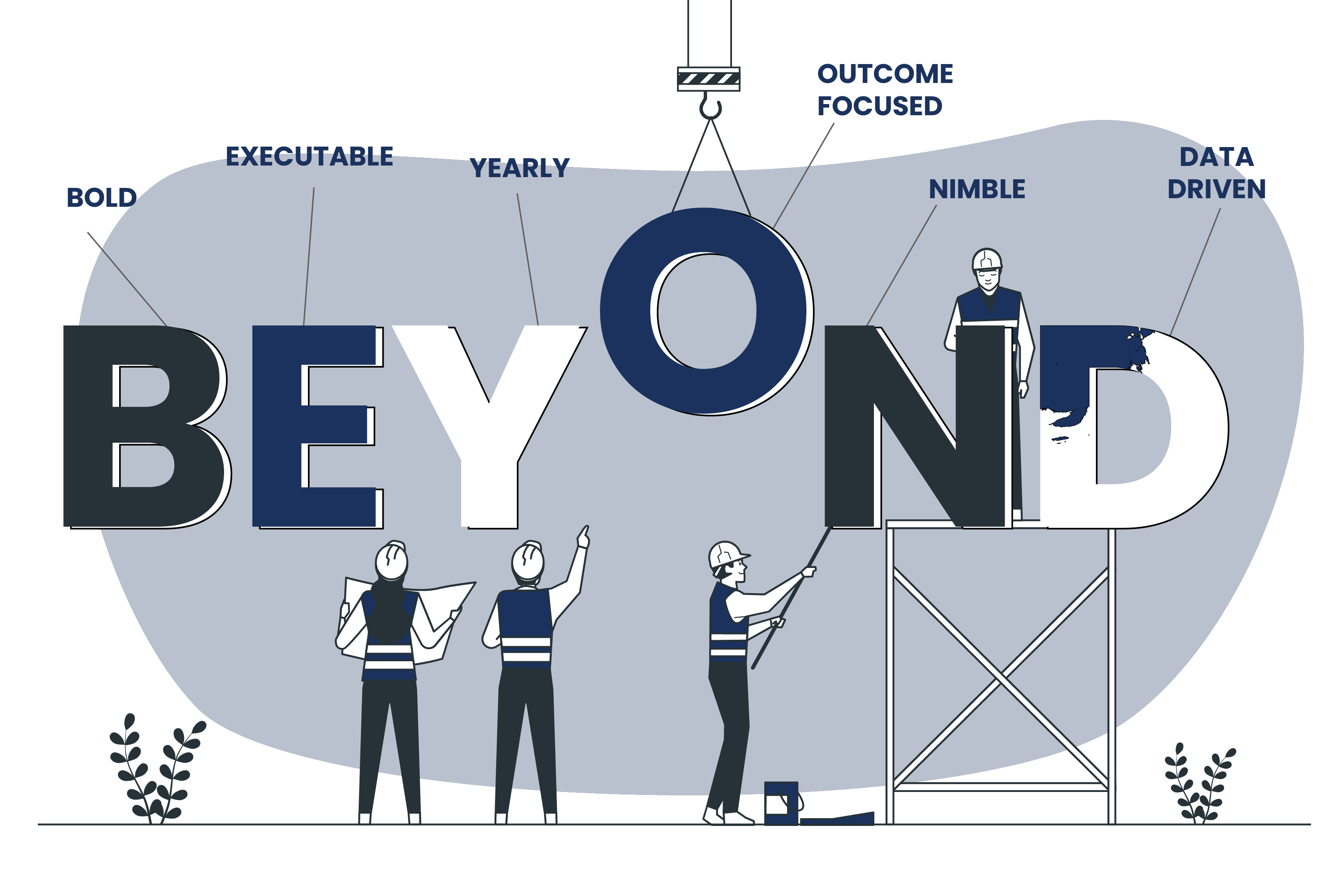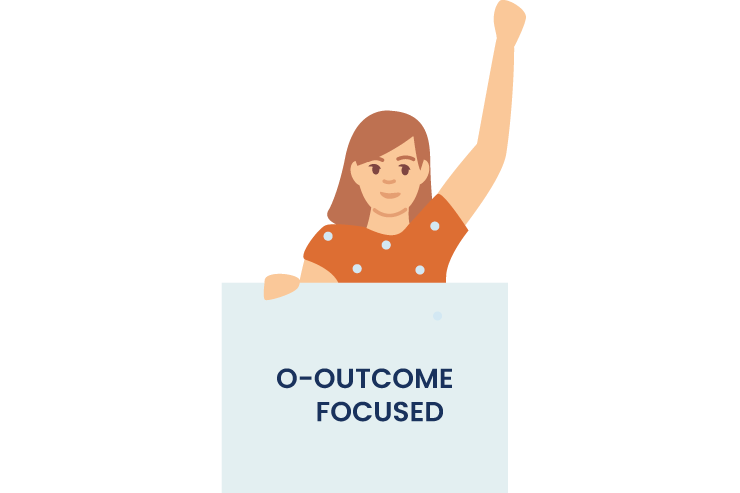Set beyond SMART admission goals for your overseas education institute

As per the recent report from Redseer, the number of Indian students opting for higher education abroad grew from 440,000 in 2016 to 770,000 in 2019 and is set to grow further to roughly 1.8 million by 2024, resulting in increased overseas spending on higher education.
These huge figures create an urgency for you to work with full focus to pull the maximum number of students towards your institution. But do you think “pulling the maximum number of students” can be your goal? Is it a well-defined goal? Is it achievable, or you are just being overly ambitious? Is your team aligned with your goal?
The above questions clearly state how important it is to set a goal and how critical it is to have a concrete goal-setting framework. The most widely used goal-setting framework is SMART, i.e., setting specific, measurable, achievable, relevant, and time-bound goals, which is massively used by organisations as it is one of the easiest ways to set relevant goals.
However, SMART has its own limitations:
- SMART sets achievable goals, but studies show people who set difficult goals are 34% more likely to achieve extraordinary results.
- Top executives are 91% more likely to enjoy leaving their comfort zone in pursuit of their goals.
- Setting a goal that requires learning new skills is nearly 10 times more powerful at inspiring employees
- 70% of people indicate varying forms of procrastination (or a general lack of urgency for their goals).
We know that you and your institute are not meant for ordinary results; you are desperate to achieve the extraordinary, and for that very reason, you need to think BEYOND SMART.
In this piece, we have come up with a BEYOND SMART thought process for setting goals that will eliminate procrastination, improve efficiency and push your team to achieve astounding results.
How to set BEYOND SMART Goals?

You need not hover around in search of “beyond smart goals.” The phrase itself has your answers. Let’s think B.E.Y.O.N.D.!
B -Bold goals

Setting bold goals that challenge you to go beyond your comfort zone is what you need to achieve more. Setting a bold goal for your institute provides clear direction and a sense of purpose. [As per a report from LeadershipIQ, top executives are 64% more likely to achieve difficult or audacious goals].
Here are some reasons why setting bold goals is beneficial for your institute:
- Setting bold goals provide clarity on the direction your institute wants to take. A well-defined goal ensures that everyone in the institute is on the same page and working towards a common objective.
- Bold goals will motivate your team and inspire them to achieve something significant. It gives your team something to work towards and creates a sense of purpose, which will boost morale and increase engagement.
- Bold goals encourage innovation and creativity, as they often require thinking outside of the box and taking risks. Pursuing a challenging goal will help your team come up with new and innovative solutions to problems.
Here’s how to set bold goals:
Data analysis: Review the data on the institute’s admissions, including the number of applicants, acceptance rate, enrollment rate, and retention rate. Identify any trends or areas for improvement.
Define the institute’s mission: Review the institute’s mission statement and determine how the admissions team can support that mission. For example, if the institute’s mission is to increase diversity, the admissions team can set a goal to increase the number of applicants from underrepresented groups.
Identifying the competitive landscape: Review the competitive landscape, including other institutes that offer similar programmes or have similar target audiences. Identify the institute’s strengths and weaknesses relative to its competitors.
For example, a bold goal for an overseas institute’s admissions team could be to increase the number of international students by 50% within the next two years. To achieve this goal, the admissions team could develop a plan of action that includes strengthening the institute’s online presence, attending international education fairs, developing a referral program, offering more scholarships, etc.
E – Executable goals

Setting an executable goal with clear action steps and timelines is important so that your team knows what to do and when. It provides a clear direction and a roadmap for achieving success. [As per the Phoenix Business Journal, only 51% of companies attempt to develop aligned goals.]
Here are some reasons why setting executable goals is beneficial for your institute:
- An executable goal helps your team focus their efforts on specific and achievable objectives that ensure everyone is aligned and working towards a common purpose.
- It creates a sense of accountability, as it establishes clear expectations for what needs to be achieved and by when. This helps team members take ownership of their work and be more proactive in achieving their objectives.
- It provides a clear metric for evaluating progress and success. This allows your team to measure their performance and adjust their approach as needed to ensure that they are on track to achieve the goal.
Here’s how you can set executable goals:
Step 1: Define the objective: The first step is to define the objective. What do you want the admissions team to achieve? For example, the objective could be to increase the number of international students at the institute by 20% in the next academic year.
Step 2: Set specific and measurable targets: Once you have defined the objective, the next step is to set specific and measurable targets. For example, the admissions team can target recruiting 50 more international students than the previous year.
Step 3: Determine the resources required: In this step, you need to determine the resources required to achieve the objectives. For example, you may need to allocate more funds to the admissions team to participate in education fairs, conduct webinars, or hire additional staff to handle the increased workload.
Step 4: Set a timeline. The next step is to set a timeline for achieving the objective. For example, the admissions team can set a timeline of six months to achieve the target.
Step 5: Monitor and evaluate progress – Finally, it is essential to monitor and evaluate the progress of the admissions team towards achieving the set objective. This can be done by setting up regular checkpoints and assessing the team’s progress against the set targets.
Y – Yearly goals

Setting yearly goals that are aligned with your institute’s strategic plan is significant as you can measure progress over time and adjust course if necessary.
Here are some reasons why setting yearly goals is beneficial for your institute:
- Setting a yearly goal prevents your team from getting stuck, pushes them towards their set objectives, and ensures everyone is striving rigorously towards a common goal.
[As per the research conducted by Ally, 90% of OKR users that utilise goal-management software check in on or update progress on their goals at least once a month. In comparison, only 65% of non-OKR users check-in or update progress on goals once a month.] - Yearly goals provide a framework for planning and decision-making. By setting clear objectives, you can more easily identify the steps needed to achieve them and allocate resources accordingly.
- Yearly goal setting halts procrastination as the team has a clear deadline in their minds. It forces them to discuss and create a plan of action beforehand, thereby limiting the chances of running out of time.
Here are some methods you can use to set yearly goals:
- SWOT analysis: Conduct a SWOT (strengths, weaknesses, opportunities, and threats) analysis of the admissions team’s performance in the previous year. This will help to identify areas for improvement and set objectives for the coming year. For example, if the analysis reveals that the admissions team has a low conversion rate of applicants to enrolled students, an objective could be to improve the conversion rate by a specific percentage.
- SMART goals: Use the SMART (Specific, Measurable, Attainable, Relevant, Time-bound) framework to set yearly objectives for the admissions team. This involves defining specific goals that are measurable and time-bound and ensuring that they are attainable and relevant to the institute’s overall objectives. For example, a SMART goal for the admissions team could be to increase the number of diversified student applications by 20% by the end of the year.
- Benchmarking: Benchmarking involves comparing the performance of the admissions team to that of similar institutes or competitors. This can help identify areas where the admissions team is falling behind and set objectives to catch up with or exceed their competitors. For example, if benchmarking reveals that the institute has a lower acceptance rate than its competitors, your yearly objective could be to increase the acceptance rate by a certain percentage.
O – Outcome-focused goals

Setting outcome-focused goals is important for an organisation as it provides a clear direction and purpose for the organisation’s efforts. It ensures that your team is clear on the desired end results and can work towards achieving them.
Here are some reasons why setting outcome-focused goals is beneficial for your institute:
- Setting outcome-focused goals will help your institute remain competitive in the international education market. By defining specific outcomes, such as increasing the number of international student enrolments your institute can focus its efforts and resources towards achieving those outcomes.
- Outcome-focused goals ensure that the admissions team’s efforts are aligned with the overall objectives of the institute. Setting aligned goals will create a more cohesive and unified approach, leading to greater efficiency and effectiveness in achieving institutional objectives.
- Outcome-focused goals help to prioritise efforts and resources. By focusing on achieving specific outcomes, organisations can direct their efforts and resources towards the most important goals while avoiding distractions or unnecessary tasks.
Here’s how you can set outcome-focused goals for your institution:
- The first step is to identify the overall objectives of the institute, so it becomes easier to identify specific outcomes that the admissions team can work towards achieving.
- The next step is to determine specific outcomes that should be specific, measurable, achievable, relevant and time-bound.
For example, your institute’s overall objective is to increase the number of international student enrolments. Your team sets a specific outcome of increasing the number of international students from India by 10% over the next year and develops a strategy of working with education agents in India with high potential for growth. They also monitor progress towards achieving the outcome by tracking the number of international student enrolments from India and making adjustments to their strategies and tactics based on the data.
N – Nimble goals

Setting goals that allow your institute to be nimble and responsive to changes in the marketplace, student needs, or internal challenges is something you cannot avoid.
Here are some reasons why setting nimble goals is beneficial for your institute:
- In a rapidly changing global environment, overseas institutes need to be agile and adaptable to respond quickly to changing circumstances. This allows the institute to respond to unexpected challenges or opportunities in a timely manner.
- Setting nimble goals will foster innovation and creativity within the institute, as the admissions team is encouraged to set goals that are not set in stone and can be revised. So it becomes more likely to think outside the box and come up with creative solutions.
- By setting nimble goals, the admissions team is encouraged to be more proactive in monitoring progress towards achieving their goals and making adjustments as needed. This can lead to improved performance and better outcomes for the institute.
Here’s how nimble goal-setting needs to be done:
- Identify the key performance indicators you want to improve or achieve. These KPIs should be specific, measurable, and relevant to the institute’s overall objectives. For example, KPIs could include improving student retention rates or increasing the number of students enrolled in specific programs (for eg. medical, engineering, psychology, etc).
- Once the KPIs have been identified, your team can develop a strategy and tactics to achieve their goals. This strategy should be flexible and able to adapt to changing circumstances or unexpected challenges. For example, the admissions team may initially plan to attend in-person recruitment fairs, but if travel restrictions are imposed, they could pivot to digital marketing and virtual recruitment fairs.
- Your admissions team should regularly review and adjust their goals as needed based on their progress towards achieving their KPIs and the changing circumstances or challenges in the global environment. This flexibility allows your institute to remain agile and adapt to the changing needs of your target audience.
D – Data-Driven goals

Using data to enrich your goals, by analysing market trends, customer needs, and other relevant metrics holds a strong significance in goal setting.
Here are some reasons why setting data-driven goals is beneficial for your institute:
- Setting data-driven goals promote accountability and transparency within the institute. When goals are based on objective data, it is easier to track progress and hold individuals or teams accountable for their performance. [A BetterWorks survey found that 92% of team members would work harder if their colleagues could see their goals.]
- Data-driven goals will promote a culture of continuous improvement within the institute. By regularly evaluating the effectiveness of its strategies and tactics based on data, you can make incremental improvements and achieve better outcomes over time.
- By setting goals that are based on data, the institute can focus its efforts and resources on the areas that are most likely to have the greatest impact.
Here’s how you can set data-driven goals:
For instance, your institute wants to increase the diversity of its student population by attracting more students from underrepresented groups. Here, to set data-driven goals, you need to:
- Collect and analyse data on student demographics and enrolment trends.
- identify the KPIs of the number of applications received from underrepresented groups, the conversion rate of applications to enrolments, and the retention rate of enrolled students from underrepresented groups.
- Based on this analysis, you need to set a measurable goal, such as increasing the number of applications received from underrepresented groups by 15% within the next year.
- The plan of action should include targeted outreach to schools and organizations that serve underrepresented groups, the development of support programs for students from these groups, and the creation of a mentorship program to support the retention of enrolled students.
Now to you
It is important to note that while SMART goals are important for setting admission targets, it is also crucial to go beyond them and consider a broader range of parameters, such as setting bold, executable, outcome-focused, nimble, and data-driven goals. By setting clear and specific goals that are aligned with the institution’s mission and values, admissions teams can work more efficiently and promote innovation through continuous improvement.
You can also get help setting goals from your team. As per the report from Collato, 80% of employees who set goals at work feel like their ideas are taken seriously, leading to increased engagement.
PS: Every organisation has its own framework for setting goals that suit its vision and mission the best. For instance, ExtraaEdge follows BHAG (big, hairy, audacious) goals to provide a powerful motivator for individuals and teams within the organisation. People in their organisation have a clear understanding of what they are working towards. They are more engaged, committed, and motivated to succeed.
Now is your time to set your goals B.E.Y.O.N.D smartly this time.


